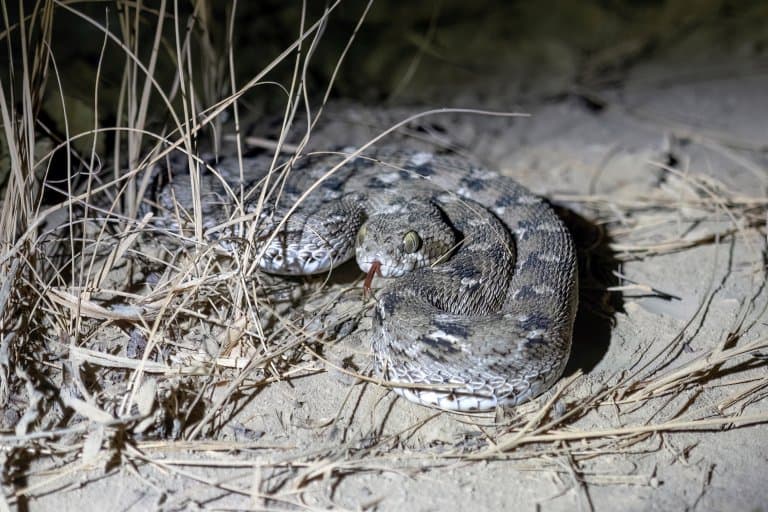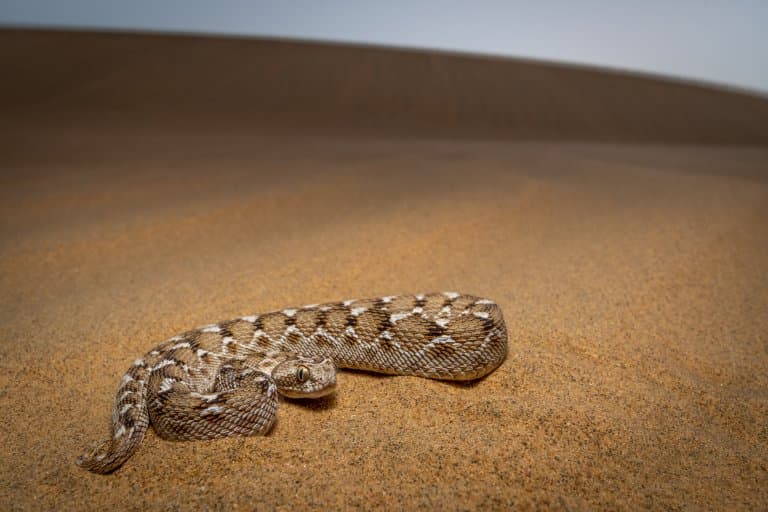Saw-Scaled Viper Profile
A Roman account dated 22 AD talks of the presence of a menacing serpent, stating, “There are snakes also of a dark red colour, a span in length, which spring up as high as a man’s waist, and whose bite is incurable.”
One of the main candidates for the species of this snake report is a relatively small snake, known as the Israeli saw-scale viper, one of many species in the most deadly genus of snakes on Earth.
Saw-scaled vipers or carpet vipers, are a genus of small venomous snakes that are found in dry regions of Africa, the Middle East and Asia (India, Sri Lanka and Pakistan).

Saw-Scaled Viper Facts Overview
| Habitat: | Desert and dry savannah regions |
| Location: | Africa, Middle East, Asia |
| Lifespan: | 24 years in captivity |
| Size: | Between 30cm and 90cm, depending on the species |
| Weight: | 150g to 400g |
| Colour: | Usually orange or red patterned |
| Diet: | Varied, smaller animals |
| Predators: | Unknown |
| Top Speed: | Unknown |
| No. of Species: | 12 |
| Conservation Status: | Least Concern (or Data Deficient, IUCN) |
The saw-scaled vipers are aptly named for a quirk of their defensive physiology.
There are at least 12 species across a wide range of tropical habitats, One of which, E. borkini is worth mentioning just because it sounds like Swedish beachwear.
While relatively little is know about their diet, they are thought to eat a variety of insects, spiders and slugs, as well as frogs, small mammals and even other small snakes.
Several species contribute to the vast majority of deaths from snake bites. They do this not just with the power of their venom but by the vigour and persistence of their attacks.
As such, the deadliest snake in the world may just be one you’ve never heard of.
Interesting Saw-Scaled Viper Facts
1. Taxonomy
The trouble with common names is that they’re largely inconsistent. As much as it might sound dorky and pretentious to use scientific names for animals in common conversation, at least they’re the same in every language (let’s choose to forget that they are constantly changing with the times).
Saw-scaled vipers, for this reason, could refer to either the saw-scaled viper Echis carinatus – also known as the carpet viper – or to the genus Echis as a whole, which is commonly referred to as “The saw-scaled vipers”.
Either way, the genus is set in stone, and that makes them all vipers, and all potentially dangerous as a result. But the name points to something they all have in common.

2. Their scales can produce a ‘sizzling noise’
These snakes have a unique ability to make a very creepy noise, and with it, a dazzling threat display.
The shape of the scales is such that when writhing about in a particularly terrifying motion, they rake against one another, creating a prolonged rattling hiss or sizzle.
Neither of these sounds is something you want to hear when you’re near a snake, and that’s the point. Like their cousins, the rattlesnakes, they’ve evolved a particular auditory warning system that lets the receiver know they’re too close for comfort.
And this is a warning worth heeding, as these snakes kill more people than any other. But its venom doesn’t pack quite the punch of some of the more notorious species of snake, so what’s the secret to its lethality? 1
3. A note on danger Vs deadly
The saw-scaled viper kills a lot of people, and yet its bites are fatal in fewer than 10% of cases, even if untreated.
Compare this with the King Cobra, whose attack kills more than half of those it envenomates, or the black mamba, whose untreated fatality rate is almost 100%, and you begin to see the flimsiness in arbitrary ranking systems, especially when it comes to ‘most deadly’.
Danger is difficult to quantify. The chance and the consequence. A low-probability event like a King Cobra bite might statistically make it safer, but that’s not much of a consolation to those who do get bitten.
On the other hand, the saw-scaled viper is a notoriously aggressive snake that lives freely in highly populated environments.
Bites occur at an alarming rate, and so despite being a lot less toxic than its competitors, the sheer prolificacy of successful bites from this animal makes it a serious candidate for most people killed.
4. They are probably the deadliest snake in the world
In the Indian subcontinent up to 50,000 die from snake bites each year.
While it’s impossible to get exact numbers, the local saw-scaled viper (Echis carinatus) is considered one of the top four most responsible for these deaths with an estimated 30,000 deaths each year.
In Africa, the most notorious of the bunch is named E. ocellatus, after its mesmerizing display of eye spots on its body. It’s responsible for more human fatalities than all other snake bites combined, despite being just over a foot long.
In Nigeria, up to 10% of the hospital beds are taken up by victims of this snake. And this is a common theme for the genus on other continents, too. 2
5. They’re small
Another surprising trait of this animal is just how little it is. Many species are no more than 30cm long, and few are more than 60.
But their size is another secret to their danger. These are easy snakes to miss when farming, or when curled up on a path in a rural community.
The small size and prevalence of this snake is the key factor in its high rate of human interactions.

6. Saw-scaled vipers are extremely aggressive
They are one of the fastest striking snakes in the world, unpredictable and highly aggressive.
By coiling in a figure of eight with its head held high, they can lash out like a spring to bite.
7. Their venom is multi-faceted
These little biters can pack a serious cocktail of venom, which is one of the reasons they’re so medically significant.
A bite from this snake can have a wide range of symptoms including random bleeding, heart palpitations, brain haemorrhage and lots of other lovely stuff.
Almost all species have a mix of hemotoxins, neurotoxins, cytotoxins and cardiotoxins, affecting more or less every type of tissue in the body. 3
8. They stole from sidewinders
Any good cowboy film has a sidewinder scene. Sidewinders are horned rattlesnakes who have adapted to traversing sandy environments by twisting their bodies in a complicated fashion to overcome the effect of loose substrate on their motion.
As well as being good at gripping loose ground, this motion keeps only two points of contact with the hot surface, likely helping to keep the snake cool when moving across deserts in the sun.
Known as sidewinding, it’s a very clever way for a snake to get around, and though these rattlesnakes are a different genus than the saw-scaled vipers, the latter has stolen their moves and taken them to India. 4
9. They even climb trees
While mostly nocturnal and hidden in burrows, buried in sand, or hidden under rocks, they can often be active after it rains or during peak humidity.
After it rains, they will climb into bushes or trees, to escape the water. 20 individuals were once observed at the top of a single cactus!
10. There is anti-venom available
At least eight different polyvalent and monovalent antivenins are available against bites from the saw-scaled viper, which means the mortality rate from snakebites is around 20%.
However, snakes that come into more frequent human contact, particularly in low income countries, with rural communites with weaker healthcare systems can be responsible for more human deaths, than the most venomous snakes.
Saw-Scaled Viper Fact-File Summary
Scientific Classification
| Kingdom: | Animalia |
| Phylum: | Chordata |
| Class: | Reptilia |
| Order: | Squamata |
| Family: | Viperidae |
| Subfamily: | Viperinae |
| Genus: | Echis |
| Species Names: | E. borkini E. carinatus E. coloratus E. hughesi E. jogeri E. khosatzkii E. leucogaster E. megalocephalus E. ocellatus E. omanensis E. pyramidum E. romani |
Fact Sources & References
- BBC Earth Unplugged (2018), “Saw-scaled Viper Makes Incredible Warning Noise before Attacking”, YouTube.
- D. A. WARRELL (1977), “Poisoning by Bites of the Saw-Scaled or Carpet Viper (Echis carinatus) in Nigeria”, Oxford Academic
- “Echis”, Science Direct.
- Raymond B. Cowles (1956), “Sidewinding Locomotion in Snakes”, JSTOR.
